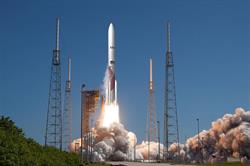What to Expect in the Space Industry in 2023 Written 4 January 2023

A concept depiction of the Centaur lifting off. | Credit: SeanMichealClemes; Wikipedia; CC BY-SA 4.0
The New York Times reports that in 2022, NASA “wowed us with cosmic scenes captured by the James Webb Space Telescope.” The DART mission “slammed an asteroid into a new orbit. Artemis I set humanity on a course back to the moon.” China finished “building a new space station in orbit, SpaceX launched 61 rockets in 12 months, and the invasion of Ukraine imperiled Russia’s status as a space power.” It’s a lot “to measure up to, but 2023 is bound to have some excitement on the launchpad, the lunar surface and in the sky.” SpaceX is building Starship for Artemis III and “numerous other rockets may take flight for the first time in 2023.” The most important, Vulcan Centaur by United Launch Alliance, “will eventually replace that company’s Atlas V, a vehicle that has been central to American spaceflight for two decades.” A number of “American private companies are expected to test new rockets in 2023, including Relativity and ABL.” They could “be joined by foreign rocket makers, including Mitsubishi Heavy Industries which could test Japan’s H3 rocket in February, and Arianespace, which is working toward a test flight of Europe’s Ariane 6 rocket.” We’re guaranteed “at least one lunar landing attempt in 2023.” A Japanese company, ispace, “launched its M1 mission on a SpaceX rocket in December.” It’s taking a “slow, fuel-efficient route to the moon and is set to arrive in April, when it will try to deploy a rover built by the United Arab Emirates, a robot built by Japan’s space agency, JAXA, as well as other payloads.”
Full Story (New York Times)
